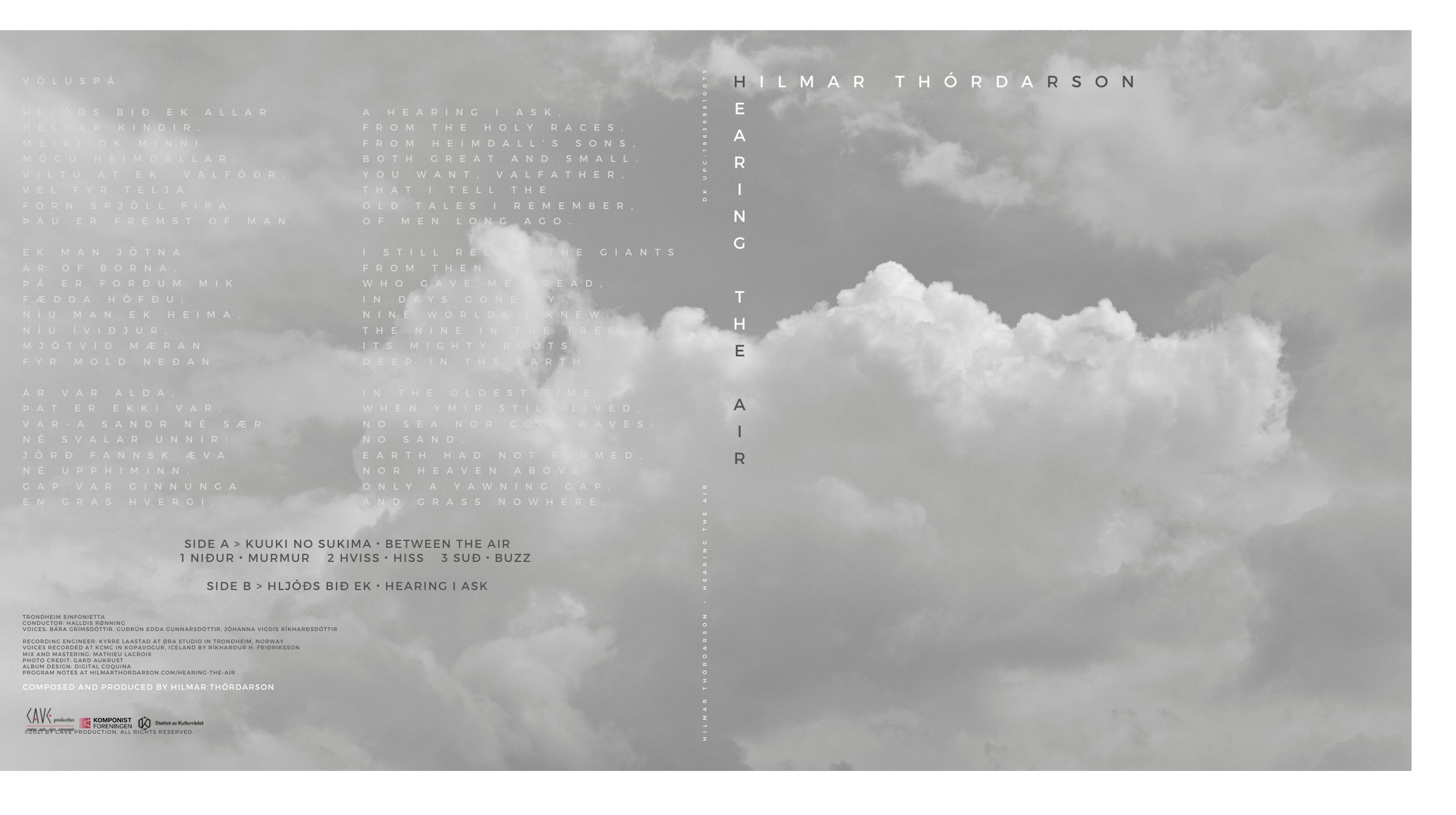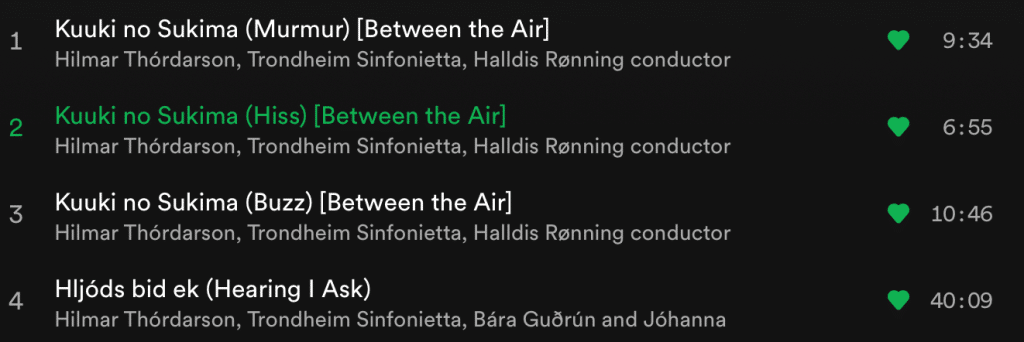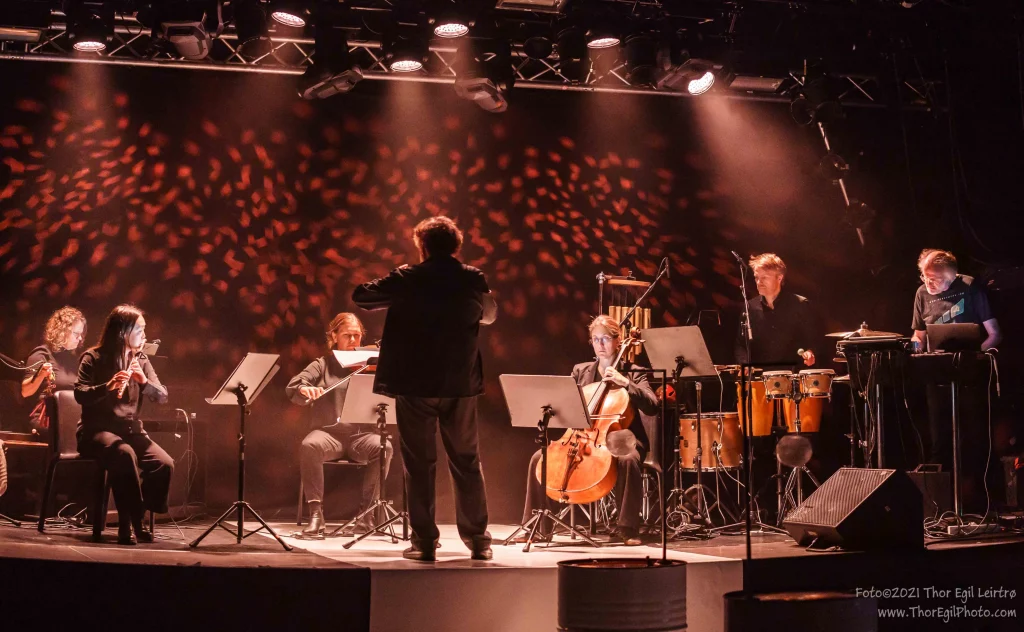Hearing the Air
Trondheim Sinfonietta plays the music of composer Hilmar Thórdarson. Conductor Halldis Rønning
Now available on Vinyl!

Also available on all major streaming services including Bandcamp and Spotify.


https://hilmarthordarson.bandcamp.com/releases

Words from the composer.
Coming from Iceland, I have a visceral connection with the natural world. Its raw beauty, its extremes of abundance and isolation, saturate Icelandic art and culture, and inform my own musical expression, at every turn of the artistic process.
The work emerges like magma – untamed and searching. Refusing fixed reference points or programmatic intent, it asserts surging independence of expression, evolving intuitively moment by moment, using internal constructs to generate abstract forms. In moments, this freeform matrix concentrates and erupts, a boiling force that explodes through the solidified surface.
About the works.
These recordings introduce two of Thórdarson’s latest compositions. Hljóðs bið ek (Hearing I Ask) and Kuuki no Sukima(Between the Air) share common musical and mystical textures, weaving instrumental and electronic sounds, mythology, and folk traditions together. The interaction between air and earth is a central theme. The composer allows his imagination to take flight and soar through the air like an invented organic creature, questing towards the Ginnungagap of Nordic mythology, that creative and powerful space that appears in Völuspá, dividing the heavy northern world of ice and wind from the sparkling, glowing south.
Conductor Halldis Rønning wearing the ConGlove for live control of electronics. Recorded live at Rockheim, Trondheim 2019. 1st movement opening.
Kuuki no Sukima (Between the Air)
This is an uncompromising composition, demanding much of both conductor and performers in its search for invocation and richness of sound. The title can be translated as ‘gap of the air’ or, as the composer prefers, ‘between the air’, both reflecting the vision of a sonic landscape, ‘out there’, between sound and pitch.
It takes us on a journey in three atonal, similar-sounding, yet easily differentiated and recognizable movements.
1st. movement,
Niður (Murmur), evokes the soft, appealing sounds of a river or distant waterfall. Starting quietly with a single violin, it builds gradually, becoming richer and fuller in its attempt to take the listener to a place – the gap – between reality and dream.
2nd. movement
Hviður (Gust), presents the composer‘s reflection on the range of sounds generated by the interaction between a gust of wind and the different elements in the landscape.
3rd. movement
Suð (Buzz), addresses that almost silent sound that elicits a subconscious, cautionary response to possible danger, sharpening our hearing. After a shocking, loud opening, the buzzing sound takes over, appearing and disappearing.
Kuuki no Sukima was written especially for Trondheim Sinfonietta and as a part of Thórdarson’s Norwegian Artistic Research project ‘ConDiS‘ (Conducting Digital System). This research explores the use of a digital glove to conduct mixed (acoustic + electronic) music – in essence, a tool that places the electronic aspects of the music directly under the conductor’s control. It was premiered at the ‘Virtuoso Listener’ in Trondheim, Norway, and that was followed by Trondheim Sinfonietta’s ‘Nordic Tour’.
The decision was made not to use the ConDiS system during the recordings. This was largely determined by the composer’s preference here for making use of the precision and possibilities of recording and post-processing for acoustic perfection.

Conductor Hilmar Thórdarson
Hljóðs bið ek (Hearing I Ask)
This work is inspired by the Icelandic mythic poem Völuspá (The Seeress’s Prophecy) as it appears in the thirteenth-century Edda of Snorri Sturluson. Völuspá is regarded as the most important textual source in Norse mythology.
The Seeress, known as a Völva, has, through prophecy, knowledge of the future which she shares with Odin, first among the gods, in the form of a creation myth and account of the world’s end. Völuspá comprises 67 stanzas, but this work draws on only the first three, which tell of the world’s creation.
Far from being programmatic, Hljóðs bið ek takes and explores particular words, deconstructing the text in sound and, through its combination of vocals, instruments, and electronics, underlines the mythic nature of the poetry. As the piece progresses, this mythological structure is revealed, ending at the Ginnungagap – the abyss or primordial space where the creation of the world takes place. The music, like clouds, forms, and re-forms, again and again, creating a multi-layered dance of sound. These swirling and floating sounds become more and more abstract in order to stimulate the imagination – offering the listener an exotic journey through these layers of sound.
Hljóðs bið ek (Hearing I Ask) was commissioned by the AJO Ensemble in Bodø, Norway for their ‘Counterpoint Project, Iceland’ in 2014.
For more information
Thórdarson’s compositions, please visit: https://www.hilmarthordarson.com/compositions/
Kuuki no Sukima, please visit: https://www.hilmarthordarson.com/orchestra-ensemble/
Hearing I Ask, please visit:
https://www.hilmarthordarson.com/hljods-bid-ek-silence-i-ask/
Thórdarson’s ConGlove, (Conducting glove): http://condis.caveproduct.com